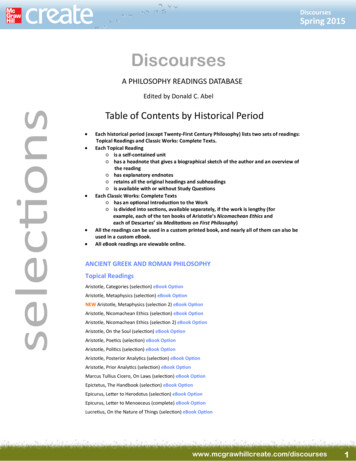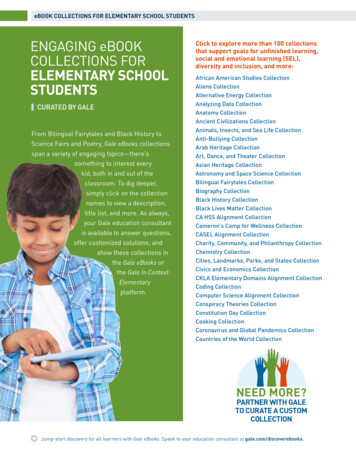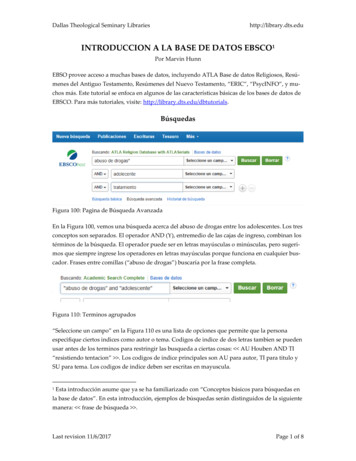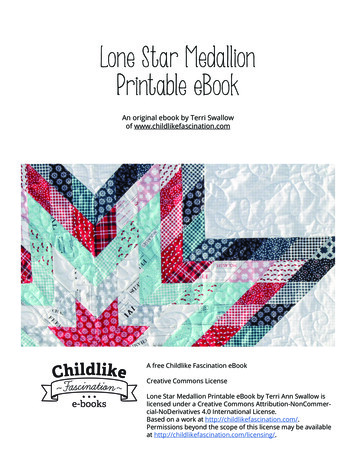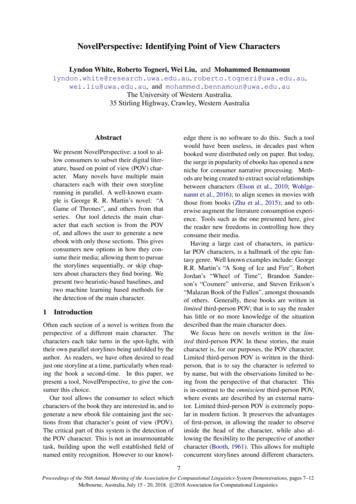
Transcription
Copyright 2016. Stylus Publishing. All rights reserved. May not be reproduced in any form without permission from the publisher, except fair uses permitted under U.S.or applicable copyright law.EBSCO Publishing : eBook Collection (EBSCOhost) - printed on 5/25/2022 4:44 AM via CHAFFEY COLLEGEAN: 1270432 ; Chávez, Alicia Fedelina, Longerbeam, Susan Diana.; Teaching Across Cultural Strengths :A Guide to Balancing Integrated and Individuated Cultural Frameworks in College TeachingAccount: s8489602
Copyright 2016. Stylus Publishing. All rights reserved. May not be reproduced in any form without permission from the publisher, except fair uses permitted under U.S.or applicable copyright law.EBSCO Publishing : eBook Collection (EBSCOhost) - printed on 5/25/2022 4:44 AM via CHAFFEY COLLEGEAN: 1270432 ; Chávez, Alicia Fedelina, Longerbeam, Susan Diana.; Teaching Across Cultural Strengths :A Guide to Balancing Integrated and Individuated Cultural Frameworks in College TeachingAccount: s8489602
Copyright 2016. Stylus Publishing. All rights reserved. May not be reproduced in any form without permission from the publisher, except fair uses permitted under U.S.or applicable copyright law.T E A C H I N G A C R O S S C U LT U R A LSTRENGTHSEBSCO Publishing : eBook Collection (EBSCOhost) - printed on 5/25/2022 4:44 AM via CHAFFEY COLLEGEAN: 1270432 ; Chávez, Alicia Fedelina, Longerbeam, Susan Diana.; Teaching Across Cultural Strengths :A Guide to Balancing Integrated and Individuated Cultural Frameworks in College TeachingAccount: s8489602
Copyright 2016. Stylus Publishing. All rights reserved. May not be reproduced in any form without permission from the publisher, except fair uses permitted under U.S.or applicable copyright law.EBSCO Publishing : eBook Collection (EBSCOhost) - printed on 5/25/2022 4:44 AM via CHAFFEY COLLEGEAN: 1270432 ; Chávez, Alicia Fedelina, Longerbeam, Susan Diana.; Teaching Across Cultural Strengths :A Guide to Balancing Integrated and Individuated Cultural Frameworks in College TeachingAccount: s8489602
Copyright 2016. Stylus Publishing. All rights reserved. May not be reproduced in any form without permission from the publisher, except fair uses permitted under U.S.or applicable copyright law.TEACHING ACROSSCULTURAL STRENGTHSA Guide to Balancing Integrated and IndividuatedCultural Frameworks in College TeachingAlicia Fedelina Chávez andSusan Diana LongerbeamForeword by Joseph L. WhiteSTERLING, VIRGINIAEBSCO Publishing : eBook Collection (EBSCOhost) - printed on 5/25/2022 4:44 AM via CHAFFEY COLLEGEAN: 1270432 ; Chávez, Alicia Fedelina, Longerbeam, Susan Diana.; Teaching Across Cultural Strengths :A Guide to Balancing Integrated and Individuated Cultural Frameworks in College TeachingAccount: s8489602
Copyright 2016. Stylus Publishing. All rights reserved. May not be reproduced in any form without permission from the publisher, except fair uses permitted under U.S.or applicable copyright law.COPYRIGHT 2016 BYSTYLUS PUBLISHING, LLC.Published by Stylus Publishing, LLC.22883 Quicksilver DriveSterling, Virginia 20166-2102All rights reserved. No part of this book may be reprintedor reproduced in any form or by any electronic, mechanical,or other means, now known or hereafter invented, includingphotocopying, recording, and information storage andretrieval, without permission in writing from the publisher.Library of Congress Cataloging-in-Publication DataChavez, Alicia Fedelina.Teaching across cultural strengths : a guide to balancing integratedand individuated cultural frameworks in college teaching / AliciaFedelina Chvez and Susan Diana Longerbeam ; foreword by JosephL. White. -- First edition.pages cmIncludes bibliographical references and index.ISBN 978-1-62036-323-2 (cloth : alk. paper)ISBN 978-1-62036-324-9 (pbk. : alk. paper)ISBN 978-1-62036-325-6 (library networkable e-edition)ISBN 978-1-62036-326-3 (consumer e-edition)1. College teaching--Social aspects. 2. Culturally relevantpedagogy. I. Longerbeam, Susan Diana. II. Title.LB2331 .C5125378.1’25--dc23201502228313-digit ISBN: 978-1-62036-323-2 (cloth)13-digit ISBN: 978-1-62036-324-9 (paperback)13-digit ISBN: 978-1-62036-325-6 (library networkable e-edition)13-digit ISBN: 978-1-62036-326-3 (consumer e-edition)Printed in the United States of AmericaAll first editions printed on acid-free paperthat meets the American National Standards InstituteZ39-48 Standard.Bulk PurchasesQuantity discounts are available for use in workshops and forstaff development.Call 1-800-232-0223First Edition, 201610987654321EBSCO Publishing : eBook Collection (EBSCOhost) - printed on 5/25/2022 4:44 AM via CHAFFEY COLLEGEAN: 1270432 ; Chávez, Alicia Fedelina, Longerbeam, Susan Diana.; Teaching Across Cultural Strengths :A Guide to Balancing Integrated and Individuated Cultural Frameworks in College TeachingAccount: s8489602
Copyright 2016. Stylus Publishing. All rights reserved. May not be reproduced in any form without permission from the publisher, except fair uses permitted under U.S.or applicable copyright law.I would like to dedicate this book to my first and most incredibleteachers—my parents, Josefita Gonzales Chávez andGabriel Venceslado Chávez.Alicia Fedelina ChávezI dedicate this book to all the teachers who have reflected my culture backto me—my parents, Esther and Gordon Longerbeam, who give me myculture. And to those who give me windows, Rosa Maria Zayas, OsaHidalgo-de la Riva, Larry Roper, Dawn Johnson, Ryan Holmes, DebBurke, Marylu McEwen, and, of course, Alicia Fedelina Chávez.Susan Diana LongerbeamEBSCO Publishing : eBook Collection (EBSCOhost) - printed on 5/25/2022 4:44 AM via CHAFFEY COLLEGEAN: 1270432 ; Chávez, Alicia Fedelina, Longerbeam, Susan Diana.; Teaching Across Cultural Strengths :A Guide to Balancing Integrated and Individuated Cultural Frameworks in College TeachingAccount: s8489602
Copyright 2016. Stylus Publishing. All rights reserved. May not be reproduced in any form without permission from the publisher, except fair uses permitted under U.S.or applicable copyright law.EBSCO Publishing : eBook Collection (EBSCOhost) - printed on 5/25/2022 4:44 AM via CHAFFEY COLLEGEAN: 1270432 ; Chávez, Alicia Fedelina, Longerbeam, Susan Diana.; Teaching Across Cultural Strengths :A Guide to Balancing Integrated and Individuated Cultural Frameworks in College TeachingAccount: s8489602
Copyright 2016. Stylus Publishing. All rights reserved. May not be reproduced in any form without permission from the publisher, except fair uses permitted under U.S.or applicable copyright law.CONTENTSForewordxiJoseph L. WhitexiiiPrefaceMusings From Alicia . . .Musings From Susan . . .Our Shared Story of Learning Across Cultural StrengthsChapter OverviewA Call to FacultyWe Are Deeply GratefulA Note About the Cover1.Balancing Cultural Strengths in TeachingReimagining Teaching Toward a Culturally Strengths-Based ApproachAcknowledging a World With Many OppressionsCultural Frameworks, Epistemologies, and WorldviewsFrom Monocultural to MulticulturalA Model of Cultural Frameworks in College Teaching and LearningIntegrated and Individuated Cultures in Teaching and LearningBoth And: A Cultural Key to LearningA Note About Inequity in LearningTeaching Within an Epistemology of Cultural Both AndApplying a Model of Cultural Frameworks to Teaching PracticeTaking It From Here to Enrich Learning Over 920575961Culture in College TeachingTheoretical Underpinnings of Our WorkA Note on Essentializing and IntersectionalityThe Changing Student Body Alongside the Relatively Unchanging FacultyStudent Completion RatesFaculty MatterCulture MattersElements of CultureEthnicity and RaceU.S. Higher Education Heritage and the Invisibility of MonoculturalismCultural StrengthsCulture Matters to Learning6365666768697074757984viiEBSCO Publishing : eBook Collection (EBSCOhost) - printed on 5/25/2022 4:44 AM via CHAFFEY COLLEGEAN: 1270432 ; Chávez, Alicia Fedelina, Longerbeam, Susan Diana.; Teaching Across Cultural Strengths :A Guide to Balancing Integrated and Individuated Cultural Frameworks in College TeachingAccount: s8489602
Copyright 2016. Stylus Publishing. All rights reserved. May not be reproduced in any form without permission from the publisher, except fair uses permitted under U.S.or applicable copyright law.viiiCONTENTSThe Expanding Nature of Learning EnvironmentsNeuroscience Supports Balancing Cultural FrameworksEngaged Learning Leads to Boundary CrossingNote3.Rewards, Dilemmas, and Challenges of TeachingAcross Cultural FrameworksCore PrinciplesOpportunities and Rewards of Culturally Engaged TeachingVulnerability of Culturally Engaged TeachingDesign DilemmasPersonal Challenges of Culturally Engaged TeachingConclusion4.Applying Cultural Introspection to Teaching andLearningGoing Inward: Knowing Ourselves Culturally as FacultyDeveloping Our Teaching Through Cultural IntrospectionLooking Outward: Learning Culturally About StudentsConclusion5.Strengths-Based Teaching in Cultural ContextGetting Started: ConceptualizingReimagining Our Teaching: The Influence of Teaching Philosophy onLearning, Student Success, and RetentionWhen Everyone’s Learning Is the Objective: Pedagogy, Facilitation, andInteraction Across Cultural FrameworksTime, Timing, and SchedulingClimate, Facilitation, and InteractionInitiating and Sustaining Student Engagement Across CulturesBalancing Activities Across Cultural Norms, Learning Processes,and PersonalitiesAdditional ConsiderationsNote6.Top 10 Things Faculty Can Do to Teach Across CulturesSelf-Reflect CulturallyModify One Cultural ContinuumTalk With Three StudentsExplore One Negative AttributionShare With Students the Value of Balancing Cultural FrameworksConnect to Student LivesPartner With StudentsMake a Personal ConnectionAssess CreativelyConsider the 177180180182EBSCO Publishing : eBook Collection (EBSCOhost) - printed on 5/25/2022 4:44 AM via CHAFFEY COLLEGEAN: 1270432 ; Chávez, Alicia Fedelina, Longerbeam, Susan Diana.; Teaching Across Cultural Strengths :A Guide to Balancing Integrated and Individuated Cultural Frameworks in College TeachingAccount: s8489602
Copyright 2016. Stylus Publishing. All rights reserved. May not be reproduced in any form without permission from the publisher, except fair uses permitted under U.S.or applicable copyright law.CONTENTS7.Spreading the Cultural Word: Faculty Developmenton a Larger ScaleOn-Campus Culture and Teaching SeminarsMultiple-Day Culture and Teaching InstitutesSustained Culture and Teaching Faculty CohortsWebsitesIndividual Self-DevelopmentInformal SharingNational and International Presentations and InstitutesResources8.The Story of Our Work With FacultyRealizing Our HopesBeginningsComing Together and PlanningPhilosophical and Organizational UnderpinningsThe Faculty Development ProjectThe ProgramFinal AssessmentResearchFaculty Group 91194195204204205Final Reflections: Toward Learning Equity: Cultivating aCulture of Belief in Students207Appendix A: Guide to Writing a Culture and TeachingAutobiography209Steps of AnalysisAppendix B: ResourcesTheory and Research on Culture and Teaching in Higher EducationTeaching Guides Related to Culture and Teaching: Collegiate,K–12, and Adult Learning SourcesFaculty Teaching IntrospectionLearning Theory and Research210215215216216216References217About the Authors225Index227EBSCO Publishing : eBook Collection (EBSCOhost) - printed on 5/25/2022 4:44 AM via CHAFFEY COLLEGEAN: 1270432 ; Chávez, Alicia Fedelina, Longerbeam, Susan Diana.; Teaching Across Cultural Strengths :A Guide to Balancing Integrated and Individuated Cultural Frameworks in College TeachingAccount: s8489602
Copyright 2016. Stylus Publishing. All rights reserved. May not be reproduced in any form without permission from the publisher, except fair uses permitted under U.S.or applicable copyright law.EBSCO Publishing : eBook Collection (EBSCOhost) - printed on 5/25/2022 4:44 AM via CHAFFEY COLLEGEAN: 1270432 ; Chávez, Alicia Fedelina, Longerbeam, Susan Diana.; Teaching Across Cultural Strengths :A Guide to Balancing Integrated and Individuated Cultural Frameworks in College TeachingAccount: s8489602
Copyright 2016. Stylus Publishing. All rights reserved. May not be reproduced in any form without permission from the publisher, except fair uses permitted under U.S.or applicable copyright law.FOREWORDTeaching Across Cultural Strengths: A Guide to Balancing Integrated andIndividuated Cultural Frameworks in College Teaching is a brilliantand engaging book written by Alicia Fedelina Chávez and SusanDiana Longerbeam, two associate professors at the University of New Mexicoand Northern Arizona University, respectively. The primary focus of thisexcellent book is the influence of culture on college teaching and learning.As we move through the Browning of America in the twenty-first centurytoward a time when people of color will become the majority Americanpopulation, increasing numbers of Native Americans, African Americans,Hispanics, Asian Americans, and immigrant undergraduate students will beentering our colleges and universities. In many cases, the teachers and students will be from different cultural frameworks. Culture as the way of lifeof a people is characterized by ways of behaving, ways of learning, norms ofconduct, skills and behavior, and patterns of interpersonal relationships andconduct passed from generation to generation.An imbalance in the teaching and learning situation exists when theteacher teaches from one cultural perspective and the student’s primarylearning experiences come from another. To enhance the possibility that thestudent will master the learning situation and achieve its deep objectives, itis important that college teachers expand their cultural reach and includemulticultural perspectives in the teaching and learning situation that recognize the cultural assets that students bring to the classroom.This book offers a comprehensive set of guidelines based on a soundtheoretical foundation, as well as empirical research that will enable collegeteachers to narrow the gap in cross-cultural teaching and student learningand assist teachers in transforming learning for all students across the manycultures that exist in the classroom. By following the steps outlined in thisbook, teachers can progressively learn about the role of culture in learningwhile transforming their teaching through introspection, reflection, practice,and the application of new teaching pedagogies that deepen student learning.Through eight well-written chapters, the authors present their ideas oncourse design, offer pragmatic insights, provide a guide for faculty to pursuecultural self-analysis, examine their assumptions about teaching, and reviewxiEBSCO Publishing : eBook Collection (EBSCOhost) - printed on 5/25/2022 4:44 AM via CHAFFEY COLLEGEAN: 1270432 ; Chávez, Alicia Fedelina, Longerbeam, Susan Diana.; Teaching Across Cultural Strengths :A Guide to Balancing Integrated and Individuated Cultural Frameworks in College TeachingAccount: s8489602
Copyright 2016. Stylus Publishing. All rights reserved. May not be reproduced in any form without permission from the publisher, except fair uses permitted under U.S.or applicable copyright law.xiiFOREWORDnarratives from students and faculty on cultural influences in teaching andlearning rhythms.This book has the potential to literally change the face of college teaching and learning from a multicultural perspective. No one who reads this textand reflects on its message can continue to teach in the old monoculturalways of teaching and learning.Joseph L. White, PhDProfessor EmeritusPsychology and PsychiatryUniversity of California, IrvineEBSCO Publishing : eBook Collection (EBSCOhost) - printed on 5/25/2022 4:44 AM via CHAFFEY COLLEGEAN: 1270432 ; Chávez, Alicia Fedelina, Longerbeam, Susan Diana.; Teaching Across Cultural Strengths :A Guide to Balancing Integrated and Individuated Cultural Frameworks in College TeachingAccount: s8489602
Copyright 2016. Stylus Publishing. All rights reserved. May not be reproduced in any form without permission from the publisher, except fair uses permitted under U.S.or applicable copyright law.PREFACEThis book guides faculty to integrate a diversity of cultural strengthsin teaching and learning processes. We strove to bring together anunderstanding of both strengths-based and culturally resonant teaching in the direction of facilitating student learning. Teaching in U.S. colleges and universities remains patterned primarily on Oxford and Germanicmodels brought to the United States early in its higher education history.Cultural influences of these models are evident in the linear, oratorical,modular ways most teaching takes place on U.S. college campuses. Ensuringlearning and success among students overall—and especially among studentsof color who originate in cultures centered in interrelational, cyclical, integrated, and contextual ways of learning—is a challenge and an opportunity.Enhancing and integrating learning inclusively for all students is becoming alarger priority—especially as student enrollments diversify ethnically and asexternal pressures are increasing to graduate students and prepare them for aglobal society. We understand from our own efforts that transforming teaching practices takes a kind of academic courage to reimagine things we holddear and to face our own cultural assumptions and patterns of practice. Weunderstand that it takes openness and a kind of humility to try to understandteaching and learning from student perspectives and to join those of us whostrive to develop a culture of belief in students. And we understand that ittakes strength and perseverance to change in the face of dominant norms andpressures to teach in profoundly new forms. We welcome you to this journeythat has meant so much to us and the students and faculty we have listenedto and worked with over the years. We wish you well in the journey.What matters most to student learning, success, and increased retentionand graduation rates is for faculty to teach from a strengths-based approach.Strengths-based approaches begin with recognizing cultural and otherstrengths that students bring to higher education and to their own learning.These approaches cultivate and draw on student strengths to engage andfacilitate inclusive learning and are derived from positive psychology andsocial work (Schreiner & Anderson, 2005). It also matters that we continueto bring strengths from our own cultural origins to balance the strengths ofothers.xiiiEBSCO Publishing : eBook Collection (EBSCOhost) - printed on 5/25/2022 4:44 AM via CHAFFEY COLLEGEAN: 1270432 ; Chávez, Alicia Fedelina, Longerbeam, Susan Diana.; Teaching Across Cultural Strengths :A Guide to Balancing Integrated and Individuated Cultural Frameworks in College TeachingAccount: s8489602
Copyright 2016. Stylus Publishing. All rights reserved. May not be reproduced in any form without permission from the publisher, except fair uses permitted under U.S.or applicable copyright law.xivPREFACEWe thought it might be helpful for you to gain a sense of our own individual culture and teaching and learning journeys as well as our shared learning across our cultural strengths. The following are individual musings aboutthe influence of culture in our own college teaching and learning and thena discussion about some of what we learned from ongoing writing, facultydevelopment facilitation, scholarship, and a deep friendship across our integrated and individuated assumptions and ways of being.Musings From Alicia . . .During our beginning conversations about this book, Susan asked me howI would describe equity among students in college. I responded, We will beequitable when all populations of students are learning and graduating at similarrates. For me it is not about getting a little bit better or a little more equitable. It is purely and simply about a responsibility I feel for the learning andsuccess of all of our students. Culture is an important factor that has beenlargely overlooked in relation to learning in college. I believe we must drawon the cultural strengths in student backgrounds and identities; blend themwith our own cultural strengths; and systematically transform our teaching,classrooms, and campuses to balance across integrated and individuated cultural norms. Until we do this across higher education institutions, profoundinequities in student learning and success will continue.My name is Alicia Fedelina Chávez, and I am Mestiza, a mixing of Spanish and Native American cultures from the time my ancestors began to intermarry in the late 1500s in what is now New Mexico. I share this with youbecause it matters. Culture matters. The norms, values, beliefs, assumptions,priorities, and behaviors that came down through the lives of my ancestors influence my teaching and learning in profound ways. I teach with thestrengths of my mother and grandmothers—searching for interconnectionsand relationships among ideas, places, events, and people. I teach with thestrengths of my father and grandfathers—facilitating learning through experiences of doing, reflecting, simulating, and imagining.I am fortunate that my family emphasized and consciously taught usabout our cultures and the meaning of them in our lives. I realize now whata gift this is in a country where not everyone is consciously aware of the richcultures of their origins. Yet culture comes down through the lives of ourancestors into our everyday lives regardless of whether we are conscious ofits presence or influence. Many of my own cultural norms became more andmore obvious to me as I left home for college, as I bumped unknowingly intoothers’ cultures and sometimes met with delighted response, yet, more often,disapproving reactions to my own.EBSCO Publishing : eBook Collection (EBSCOhost) - printed on 5/25/2022 4:44 AM via CHAFFEY COLLEGEAN: 1270432 ; Chávez, Alicia Fedelina, Longerbeam, Susan Diana.; Teaching Across Cultural Strengths :A Guide to Balancing Integrated and Individuated Cultural Frameworks in College TeachingAccount: s8489602
Copyright 2016. Stylus Publishing. All rights reserved. May not be reproduced in any form without permission from the publisher, except fair uses permitted under U.S.or applicable copyright law.PREFACExvAs I journeyed through my own college education at four universities indisparate parts of the country, I became adept at identifying and negotiating cultural differences and similarities. I learned when I took on the role ofteacher for the first time that collegiate classrooms are usually highly monocultural in nature. Student and faculty expectations jarred and shocked me,even with many years of experience in predominantly White universities andcolleges. I entered a new country in many ways as I began to teach and overtime developed a synergy among who I am, who my students are, and thesubject matter. Even after my first class session, students of color inquiredhow it was that I taught as their elders had, sharing their relief at learning within cultural norms similar to their own. A few students of NorthernEuropean cultural origins also found relief and joy in experiencing new waysof learning and some in finding their own unique learning rhythms in myteaching. Yet more than a few challenged my ways of teaching in very direct,sometimes belligerent, cruel, or even highly inappropriate ways. I will alwaysremember learning that one student made an appointment with the provostto complain. Fortunately, the provost, an anthropologist, pointed out to thisyoung man he was privileged to be learning in new ways that would assisthim to negotiate a global society. What developed in me from this journeywas an ever increasing passion for understanding culture and drawing on itsdiverse strengths and a fascination with how culture manifests in both student learning and teaching practice.My sense of urgency about teaching more systematically across culturalframeworks actually happened in a roundabout way. One semester I wasfaced with teaching a group of graduate students in which more than halfidentified as learning disabled. I strive to facilitate learning in ways effectivefor all students, so I made an appointment to see the director of the Officeof Accessibility at that university. She introduced me to Gardner’s theories ofmultiple intelligences (see Gardner, 2006) and explained that teaching acrossintelligences would help all of my students learn better. This changed my lifeas a teacher in many ways, including my systematic ability to design coursesand facilitate learning more effectively across cultures.I began to balance pedagogies across multiple intelligences when facilitating my class sessions. I also began to inquire more purposefully of studentshow they learn naturally and then modify assignments, introduce students toGardner’s intelligences at the beginning of courses, and work differently whenassisting struggling students. I remember one student who came to me andshared that he had never been a good writer and yet our program requiredmostly extensive papers. He said that other faculty kept giving him writingexercises and sending him to the campus writing center; it wasn’t helpinghim. I had a flash of insight to work with him from his learning strengthsEBSCO Publishing : eBook Collection (EBSCOhost) - printed on 5/25/2022 4:44 AM via CHAFFEY COLLEGEAN: 1270432 ; Chávez, Alicia Fedelina, Longerbeam, Susan Diana.; Teaching Across Cultural Strengths :A Guide to Balancing Integrated and Individuated Cultural Frameworks in College TeachingAccount: s8489602
Copyright 2016. Stylus Publishing. All rights reserved. May not be reproduced in any form without permission from the publisher, except fair uses permitted under U.S.or applicable copyright law.xviPREFACEand asked him to share with me his two top intelligences. He said they werediscussion (interpersonal) and visual/spatial. So I asked him to bring a taperecorder to our next appointment where I had crayons and newsprint ready. Itoccurred to me that perhaps the way to learning for this student wasn’t throughany kind of writing but rather through his more natural intelligences first as away into writing. So I interviewed him about the assignment (interpersonal),asked him to share some of his thoughts and ideas, and had him tape-recordthe interview to take home. Then I gave him crayons and newsprint andasked him to draw or chart out his ideas (visual/spatial). I encouraged him totransfer ideas from both the recording and his newsprint to write his paper.This student did well in my class, but I didn’t see him much as he finished his master’s. What startled me was that he ended up winning the writing award for our program, and when he got up to share at our program’sgraduation celebration, he shared this story and said that finding nonwritingways into his ideas was a turning point in his learning and gave him a way,using his own strengths, to do things he hadn’t been able to do before—eventhings at which he had never been good, like writing.I learned almost immediately that diversifying my pedagogies acrossintelligences and working with students from their strengths also made adifference in my ability to teach across cultures as students of color, bothdomestic and international, began approaching me after classes to share thatI was often their first professor who included learning processes from theways they were taught in their families, tribes, countries, and communities.Student reactions served as a catalyst for my research on cultural strengthsin college teaching and my work with faculty on teaching across culturalframeworks.I am profoundly changed through transforming my teaching for diverselearners, and my journey continues as I develop more overt ways to transformpedagogy, interactions, communications, and facilitations across culturalframeworks to enhance student learning and success.Like mine, your culture(s) of origin influence your teaching—regardlessof whether culture is consciously held in your life or not. In addition, students’ learning is influenced by their cultures of origin. Like culture, teachingand learning are in many ways learned phenomena, which means that we cantransform our teaching to integrate a balance of cultural norms and enhancestudent learning.As teachers we have a responsibility to design and facilitate responsivelyto the needs of a diversity of students. It is helpful to understand that how welearn is greatly influenced by the cultural norms, epistemologies, and worldviews in which we were raised, regardless of whether they are consciouslyunderstood as culture. It is crucial subsequently to assess ways our teachingEBSCO Publishing : eBook Collection (EBSCOhost) - printed on 5/25/2022 4:44 AM via CHAFFEY COLLEGEAN: 1270432 ; Chávez, Alicia Fedelina, Longerbeam, Susan Diana.; Teaching Across Cultural Strengths :A Guide to Balancing Integrated and Individuated Cultural Frameworks in College TeachingAccount: s8489602
Copyright 2016. Stylus Publishing. All rights reserved. May not be reproduced in any form without permission from the publisher, except fair uses permitted under U.S.or applicable copyright law.PREFACExviireflects one or more worldviews from our own ways of learning and begin toincorporate a wider diversity of cultural norms into our practice. This is critical especially to those students whose cultures originate outside those prevalent in college and university teaching. It is also critical that all of our studentsbecome adept at learning within a wider cultural context because learninghas become an essential skill in the workplace and the wider global society. Indivi
Library of Congress Cataloging-in-Publication Data Chavez, Alicia Fedelina. Teaching across cultural strengths : a guide to balancing integrated . printed on 5/25/2022 4:44 AM via CHAFFEY COLLEGE AN: 1270432 ; Chávez, Alicia Fedelina, Longerbeam, Susan Diana.; Teaching Across Cultural Strengths : A Guide to Balancing Integrated and .
